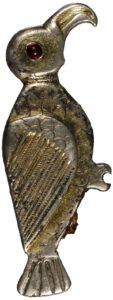 Excavation of a necropolis in the ancient Roman town of Boutae, near Annecy is southeastern France, has yielded rich Germanic funerary furnishings. Radiocarbon dating and analysis of the artifacts dates the necropolis to between the second half of the 5th century and the second half of the 7th, indicating there was a stable population of Burgundians living in Boutae after the establishment of the First Kingdom of Burgundy in the Rhineland and Savoy in 443.
Excavation of a necropolis in the ancient Roman town of Boutae, near Annecy is southeastern France, has yielded rich Germanic funerary furnishings. Radiocarbon dating and analysis of the artifacts dates the necropolis to between the second half of the 5th century and the second half of the 7th, indicating there was a stable population of Burgundians living in Boutae after the establishment of the First Kingdom of Burgundy in the Rhineland and Savoy in 443.
Boutae was founded in 27 B.C. as a vicus, a small satellite town of the main city of the Allobroges tribe. Located at the intersection of three major  Roman roads and on the Alpis Graia, the route leading to the Petit Saint-Bernard alpine pass, Boutae prospered under the Roman Empire. It was razed and much of the population killed in the Germanic invasions of the mid-3rd century, but it was rebuilt in the 3rd century. The vicus was largely abandoned in the early 5th century in the wake of the Burgundian invasion, but some of pockets of the town were used until the end of the 7th century.
Roman roads and on the Alpis Graia, the route leading to the Petit Saint-Bernard alpine pass, Boutae prospered under the Roman Empire. It was razed and much of the population killed in the Germanic invasions of the mid-3rd century, but it was rebuilt in the 3rd century. The vicus was largely abandoned in the early 5th century in the wake of the Burgundian invasion, but some of pockets of the town were used until the end of the 7th century.
The presence of graves from late antiquity on the west side of the city has been known since the 19th century, but it wasn’t thoroughly excavated and 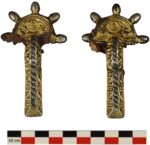 documented until last year. INRAP archaeologists explored almost half an acre and unearthed 227 graves, a fraction of the total burials at the site. There are a variety of grave types including wooden coffins, hollowed out trunks, sandstone slabs. Thirty of the graves contained high quality furnishings, either worn by the deceased or placed in the pit. Their decorative style mark the grave goods as Burgundian.
documented until last year. INRAP archaeologists explored almost half an acre and unearthed 227 graves, a fraction of the total burials at the site. There are a variety of grave types including wooden coffins, hollowed out trunks, sandstone slabs. Thirty of the graves contained high quality furnishings, either worn by the deceased or placed in the pit. Their decorative style mark the grave goods as Burgundian.
 Most of the objects are objects of adornment or grooming. There are a dozen decorated bone combs, glass beads on necklaces and châtelaines, belt buckles, shoe buckles, a three-piece toiletry kit, a silver gilt fibula shaped like a bird of prey with a garnet eye and a matched set of fibulae in the shape of galloping horses. Only two weapons were found: an arrowhead and a scramasax with a fragment of its wooden scabbard still attached.
Most of the objects are objects of adornment or grooming. There are a dozen decorated bone combs, glass beads on necklaces and châtelaines, belt buckles, shoe buckles, a three-piece toiletry kit, a silver gilt fibula shaped like a bird of prey with a garnet eye and a matched set of fibulae in the shape of galloping horses. Only two weapons were found: an arrowhead and a scramasax with a fragment of its wooden scabbard still attached.
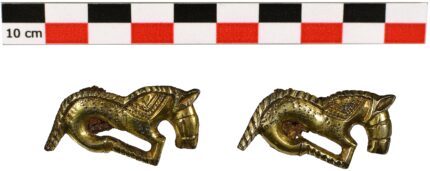
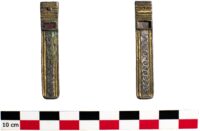
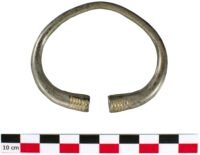
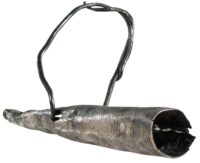
There may have been a few Huns involved 😉
Gundahar, better known by his legendary names Gunther or Gunnar, was king of Burgundy in the early 5th century. He had been involved in the campaigns of the failed Roman usurper Jovinus, before being settled on the left bank of the Rhine as a Roman ally.
In 436, Gundahar launched an attack on the Roman province of Belgica Prima but was defeated by the Roman general Flavius Aetius, who destroyed Gundahar’s kingdom with the help of Hunnish mercenaries the following year, resulting in Gundahar’s death in 437AD.
According to the Elder Pliny in the 1st century AD, i.e. until they ended up in Burgundy, those Burgundians clearly came from the (North) East:
—–
Τῶν δὲ ἐντὸς καὶ μεσογείων ἐθνῶν μέγιστα μέν ἐστι τό τε τῶν Συήβων τῶν Ἀγγειλῶν, οἵ εἰσιν ἀνατολικώτεροι τῶν Λαγγοβάρδων ἀνατείνοντες πρὸς τὰς ἂρκτους μέχρι τῶν μέσων τοῦ Ἄλβιος ποταμοῦ, καὶ τὸ τῶν Συήβων τῶν Σεμνόνων, οἵτινες διήκουσι μετὰ τὸν Ἅλβιν ἀπὸ τοῦ εἰρημένου μέρους πρὸς ἀνατολὰς μέχρι τοῦ Συήβου ποταμοῦ, καὶ τὸ τῶν Βουργουντῶν τὰ ἐφεξῆς καὶ μέχρι τοῦ Οὐιστούλα κατεχόντων.
“Of the people of the interior and those wo live inland the most important are the Suebi Angili, who are to the east of the Langobards, extending towards the north and up to the central part of the Elbe river, and the Suebi Semnones, whose boundaries beyond the Elbe extend from the area we mentioned towards the east up to the Oder river, and the Burgundians, who inhabit from there to the Vistula.”
—–
en.wikipedia.org/wiki/Gunther
en.wikipedia.org/wiki/Nibelungen#Lex_Burgundionum
en.wikipedia.org/wiki/Nibelungenlied
Oh Dear ..I knew there was something wrong..
Of course, “Pliny” presumably did not write in Greek, and in fact he did not write this at all:
It was “Ptolemy” a century later. Sorry for the confusion :confused: